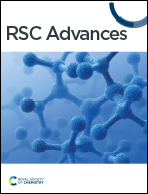Phosphomolybdic acid hydrate encapsulated in MIL-53 (Fe): a novel heterogeneous heteropoly acid catalyst for ultrasound-assisted regioselective nitration of phenols†
Abstract
In this study, a heterogeneous catalyst, PMA@MIL-53 (Fe) (MIL ⇒ Matériaux de l'Institut Lavoisier), has been used to replace the usual mineral acids such as sulfuric acid. A wide variety of nitration methods require the use of a mixture of acids such as concentrated nitric acid and sulfuric acid, which result in producing a large amount of acidic waste. During recent years, the use of the heterogeneous system for the nitration of aromatic compounds has been highly considered and used by chemists due to some specific advantages, i.e. easy separation of the product from the reaction mixture, the possibility of recycling and reusing the catalyst, etc. Herein, the catalyst was synthesized using a metal–organic framework and a heteropoly phosphomolybdic acid. The PMA@MIL-53 (Fe) was prepared using a similar method of MIL-53 (Fe) synthesis. Afterwards, FeCl3·6H2O and 1,4-benzene dicarboxylic acid (BDC) in a dimethylformamide solution were placed in an ultrasound bath and, then, HPA (heteropoly acid) was added to the reaction mixture. The PMA (phosphomolybdic acid) encapsulation in MIL-53 (Fe) was confirmed using various analysis. Under optimal conditions, the catalytic activity of PMA@MIL-53 (Fe) was evaluated in nitration of phenol under ultrasonic waves. Besides, the ratio of the two products of ortho and para was obtained using GC. Optimum conditions were reached after 15 minutes, in such a way that the loaded PMA was 0.02 g under optimal conditions, the efficiencies of ortho-nitrophenol and para nitrophenol were 54.98 and 45.01, respectively.



 Please wait while we load your content...
Please wait while we load your content...